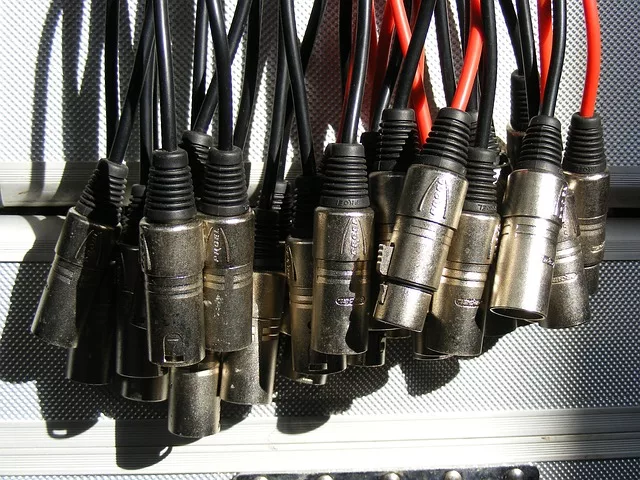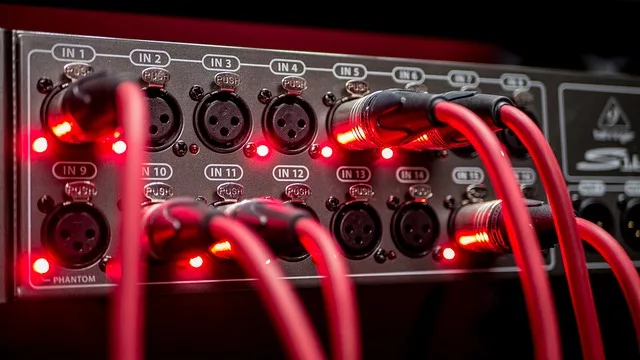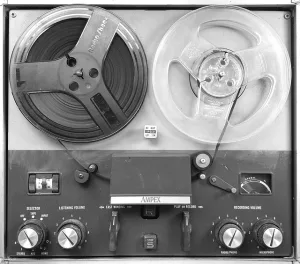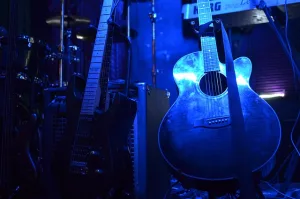DISCLAIMER: Parlor City Sound earns a commission (at no cost to you) if you click a link to Amazon and buy something while visiting this page. This is only applicable to Amazon links—we don't earn a sales commission from anyone else. Read our advertising disclosure & FAQ to learn more about our strict policies on affiliate marketing.
While learning about DIY home recording, you’re going to encounter the phrase stage snake (or stage box, or audio snake … they all mean the same thing). And hearing about them will likely stir up a fairly obvious question. What is a stage snake, and why are they useful?
A stage snake is just a bunch of audio cables combined into one big mega-cable. You can plug microphone and instrument cables into one end of the snake, and devices into the other. For instance, an audio mixer, an audio interface, a mic preamp, or perhaps a signal processor. In other words, a stage snake lets you send multiple inputs to multiple outputs over a single cable.
How does a stage snake work?
A stage snake has three distinct parts. The cleverly-named “box end” is a box with multiple cable inputs, which are usually for XLR (microphone cable), TRS (instrument cable), or both. The middle bit of the snake looks like an oversized cable, but it’s actually lots of cables grouped together inside a large sheathing or tube. And last but not least, we have the “fan end” of the snake, which consists of the loose, ungrouped output cables.
The fan end cables are individual so you can plug them into different devices separately. For example, you might have some of your fan end cables running to a mixer, and others going to preamps.
Most (but not all) stage snakes also have returns, which allow you to send signals from the fan end to the box end. Returns are great to have in the studio, because you can plug headphones into them to hear playback. They’re useful on stage, too, for monitors and whatnot.
Stage snakes are usually pretty long, ranging anywhere from 20 to 100 feet or even longer. So when you’re shopping for a stage snake for your home studio, be mindful of how long it is. You don’t really need a 100-foot snake for most home studio applications.
What is a stage snake used for?

Stage snakes are commonly used in live settings, hence the name. It’s a lot easier (and way more organized) to replace lots of cables with one cable, reducing trip hazards and avoiding big, sloppy, tangled cable nightmares all over the stage.
But what is a stage snake used for in a recording studio? Well, pretty much the same thing. A snake provides you with one centralized location to plug in all of your microphones. You’re running a single cable through a wall from your live room to your control room, rather than lots of cables. It’s a relatively affordable device that drastically improves efficiency and reduces clutter.
What is a digital stage snake or digital stage box?

Given their explosive popularity growth in recent years, you may have heard of digital snakes too, like this Behringer S16. So what is a digital stage snake? How are they different from an analog snake?
A digital stage snake is a component of a digital audio network where everything is connected via high speed ethernet cables. That bulky, cumbersome, oversized analog snake cable is replaced by a tiny, maneuverable ethernet cable. And that networking cable plugs directly into an audio interface or a digital mixer. You could even use a router that sends signals to multiple devices all at once.
Digital snakes take up way less space, with their smaller cables and (usually) rackmounted box ends. But there are drawbacks to using digital snakes, too. Digital audio networks are complicated, with a steep learning curve and a dizzying list of platforms that can be confusing to navigate. And they’re quite expensive, priced out of contention for a budget-conscious home recording studio. That extra money is honestly better spent investing in better recording studio microphones and preamps.
What is a stage snake worth? How much do they cost?
Let’s wrap this up with one final common question: What is a stage snake’s cost? Are they expensive?
A mid-sized 12×4 analog stage snake (meaning the box end has 12 inputs and four returns) will typically cost anywhere from $100 to $400 or thereabouts. A larger 24×4 stage snake will run you between $300 to $600 or more. Digital snakes are of course a lot more expensive, usually costing around $400 for simple, barebones stage boxes, while fancier options can end up costing you $3,000 or even more. And that’s before you factor in the other costs associated with setting up a digital audio network at home. Cable length, input and return counts, and connector types will all factor into the price.
Some of the popular brands making stage snakes include ProCo, Livewire, Seismic Audio, On-Stage, Elite Core, Harmony Audio, and Hosa. Try calling local music stores in your area to see if they carry stage snakes. Otherwise, you can follow those links to Amazon we just shared (note: we earn a commission from those purchases, at no cost to you), or try shopping online through stores like Sweetwater or Musician’s Friend.
Stage snakes are a great investment for a home recording studio. They simplify the process of setting up for recording and reduce clutter. They’re also a lot cheaper than installing connectors into the wall directly. Which isn’t an easy thing to do if you aren’t an electrician. We recommend figuring out how many inputs and returns you need, measuring up your space so you get the right length, and then researching stage snakes you find online to make sure you’re getting a good one.
Also worth checking out: How to record a full band on the cheap




